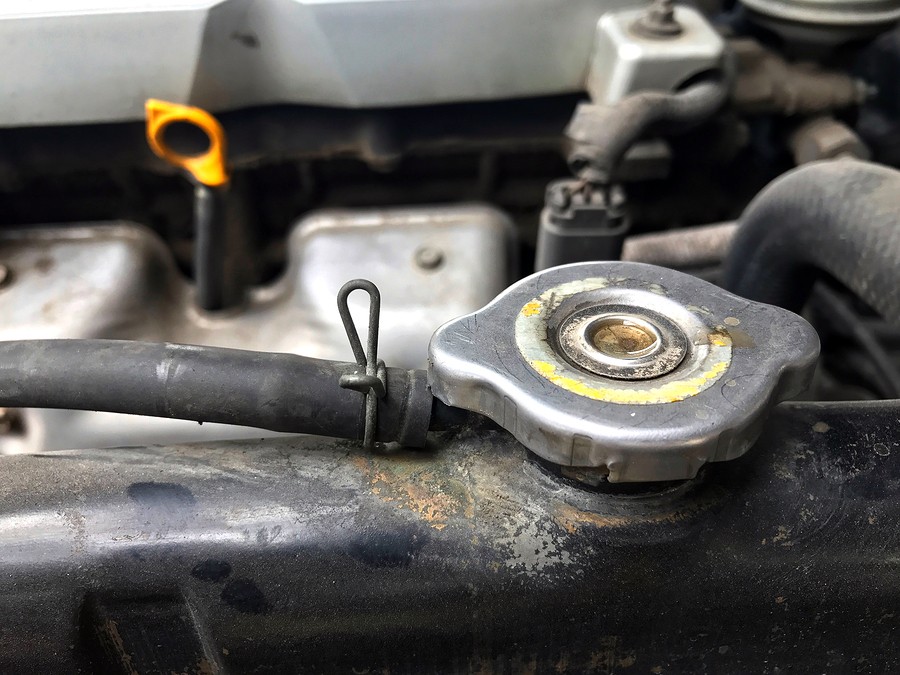Dogs pant, humans sweat, and cars use radiators to regulate temperature. A radiator is integral to a car’s ability to do its honorable job of staying reliable for the owner. A car for most of us almost becomes a trustworthy friend. You count on your car daily to get you from point A to point B, without your vehicle life become one giant inconvenience. No one wants to rely on taxis, rides from family or friends, and absolutely no one wants to experience the horrors that is public transportation. Keeping your car “healthy” is important and just like a human a car can’t afford to overheat, nor does anyone want to deal with the high costs to repair a radiator. The average cost to replace a radiator ranges from $300-$1200.
What Exactly is a Radiator?
A radiator is an essential part of the cooling system for your vehicle. It works in conjunction with an entire system, including the water pump, to keep your car's engine at optimal temperature while it is in motion and while it is at rest. The radiator system is comprised of a large, flat, metal device with very small fins built into the front side of the radiator. These small fins are designed to increase the surface area of the radiator exponentially. The larger surface area allows increased airflow across the surface and therefore the higher potential for cooling. The liquid circulates through the radiator, this used to be water and now it is coolant or sometimes referred to as antifreeze. As the hot liquid passes through the radiator and behind the radiator fins the cooling effect from the air passing over the surface cools down the liquid that is also passing directly beneath the surface as well. This is commonly referred to as heat exchange.
The principle of a radiator is that it is most effective while there is maximum air flow across the surface of the radiator, which will maximize cooling. While the vehicle is at rest, there's actually no airflow going through the radiator and therefore the liquid in the system can become quite hot. To accommodate this very common situation, such as stop and go traffic, radiators are always equipped with a radiator fan that runs while the vehicle is not in motion.
What Causes Radiator Failure?
Radiators can fail for a wide variety of reasons that range from poor maintenance to accidents and manufacturer defects. We will cover the most common reasons for radiator failure here but rest assured, these are not the only reasons why a radiator might fail.
- Corrosion: A Radiator is made almost exclusively of metal and metal will corrode over time. Radiators make use of antifreeze or engine coolant which not only provides a mechanism for cooling but also has anti-corrosive properties as well. If you do not change your engine coolant frequently enough, then you will have issues with corrosion forming within your system. This corrosion can lead to plugs or stoppages within the radiator channels, preventing coolant from actually moving through the radiator and leading to a breakdown or overheating.
- Electrolysis: Electrolysis comes from a bad engine ground. if Your engine is not properly grounded, then electrical current can flow through the motor and into your coolant. This electrical current, combined with the electrical current that is flowing to your coolant, will lead to issues with the deterioration of the metals within your radiator overtime.
- Accidents or Damage: One of the most common reasons for radiator failure is the occurrence of road debris hitting the radiator or radiator structure. As you drive along, all matter of debris is kicked up underneath your vehicle. Since the front of your car is maximized for air flow, this can lead to this debris striking your radiator. Worse yet, if the debris is larger, it can dislodge the radiator supports, knock off coolant hoses or punch a hole in your radiator! Any damage to the fin system of the radiator will lead to issues with cooling and therefore the eventual demise of the radiator.
How Can I Tell My Radiator Is Failing?
You can tell your radiator is failing from a few key signs that start to show themselves once your radiator or your cooling system begins to develop issues. Here are the main culprits:
- Running Hot: Your car is constantly running hot. Every vehicle has a temperature gauge within the instrument cluster that can indicate to the driver how hot the engine is or is not. If you noticed that this gauge is consistently on the high side, or near the red zone of the gauge, then your vehicle's engine is running hotter than it should.
- Coolant Loss: Another Telltale sign of radiator failure or cooling system failure, in general, is when the coolant is found underneath your vehicle after it is driven for a period of time. This shows that your vehicle is losing coolant from its main system and therefore losing the ability to effectively cool your engine!
- Coolant Sludge: The color of the cool in your vehicle should be a bright yellow or bright green. As your radiator begins to fail, this brightly colored coolant does colors becomes infected with the contaminated metals within your radiator. This sludgy mess will not effectively cool down your vehicle’s engine.
- Low Coolant: If you notice that your vehicle's refill tank is consistently low, even after adding fluid to it, then you have an issue with coolant loss somewhere within your system. As mentioned above, this will lead to your vehicle eventually overheating.
How Much Does A Radiator Replacement Cost?
The toughest part about a failing radiator is the high cost that is involved. Unfortunately, a radiator is an expensive piece of equipment and is typically a process that involves a high amount of labor. According to RepairPal, here are some popular cars and their associated cost to replace the radiator only.
| Year | Make | Model | Price |
| 2005 | Toyota | Camry | $483 – $824 |
| 2006 | Scion | tC | $386 – $592 |
| 2000 | Honda | Civic | $387 – $737 |
| 2004 | Honda | Accord | $443 -$577 |
| 2004 | BMW | 325i | $487 – $687 |
As you can see, there is a wide variety of prices depending on the type of vehicle you own. However, these repair prices are still quite high and do not include other things such as belt replacements, coolant hose replacements or other related repairs.
Why Is It Expensive To Repair A Radiator?

The radiator itself is a quite expensive part, often ranging from around $100 to well over three or four hundred dollars! Beyond that point, the radiator is an integral part of the front of your vehicle. In order to access the radiator, a technician has to remove all structural pieces from the front of your vehicle. In other words, they need to take off the entire bumper assembly to properly access your radiator! This will absolutely lead to high labor cost, often taking an experienced technician several hours to complete.
It is also common practice to repair other items related to your radiator while the front of your vehicle is open. The components include:
- Radiator Fan
- Coolant Hoses
- Radiator Support Structure
- Gaskets and Connections
- Drain Plug
You may not be dealing with only the cost to replace a radiator but also the cost to repair other parts of the cooling system that were damaged by your radiator’s failure! Typically a car repair cascades from one issue into another, as all parts of your vehicle are designed to work in harmony with one another. A good example of this phenomenon are your vehicle’s head gaskets. If your vehicle overheats due to the failure of your radiator, then your head gaskets can become overworked and also fail due to warping. The issues just keep on rolling!
Is It Worth Replacing Your Radiator?
Before you make a decision to make the costly investment in your old vehicle by replacing your radiator, you are going to want to investigate what your car is actually worth. The internet offers us numerous tools that can help make an annoying task like estimating the value of our car easily. Websites like Kelley Blue Book and Edmunds are great tools offered to the public. Keep in mind that the numbers you get from these sites are estimates only and most people who buy vehicles for a living will indicate that these prices are always on the high side. In reality, it’s just a ploy to make money.
If your radiator is failing, you need to remember that there is a good chance that other pieces of your vehicle's engine will also be failing as well. It is almost a guarantee that a radiator that has failed will have allowed hotter than recommended coolant to flow through the motor and this superheated coolant will cause major issues for you down the road. You may fix your radiator now but be looking at another series of repairs down the road. This is not a scare tactic but it is an absolute reality. The cooling system of your vehicle simply plays that large of a role!
These realities need to be balanced against the actual value of your car. If your car has very little value and has the potential for a high radiator repair cost, then it doesn't seem to be worth it to repair your vehicle just to have it still be worth very little. There are absolutely other options for you that will put cash in your pocket today and allow you to go buy a car that is more reliable. Get rid of your money pit today!
You Can Sell Your Car As-Is

Selling your car today is much easier than it ever used to be. We have tons of options at our fingertips that will allow us to get the cash for the vehicle that is sitting broken in our driveway or that has been a money pit for years. Your car is full of valuable parts, metals, and components that are quite valuable to people who are looking to recycle and reuse parts of your car. Now the question is, who buys such cars that seem like they have no value to the average consumer? Truth be told, you have a few options such as Craigslist, junkyards, eBay and even car dealerships. All of these come with their own set of pros and cons.
When you decide to list your vehicle online you open yourself to scammers who will contact you at crazy hours with crazy offers. Although there will be legitimate buyers who may want your vehicle it is hard to wade through the illegitimate calls, emails, and texts. Listing your car on eBay does not exclude you from these headaches and requires you to pay follow a very strict set of rules. You will be given two options on eBay, to list it locally or to list it nationally which will cost you a fee to do so. Craigslist, while it is extremely easy and accessible to everyone is literally teeming with people who want to scam you for your hard earned dollar.
The main thing to remember is that all types of buyers basically work the same way. They are interested in purchasing your broken or non working car and turn it into a profit! Junkyards and dealerships will promise you the world and then hit you with sleazy sales tactics once you get your car down to the yard or lot. Remember, if your car is non operable, there’s a good chance you’ll have to pay to have it towed there yourself. Once you’ve already paid to have it towed, you’re more likely to just take whatever price you’re given to less your hassle. It’s a tactic these types of businesses know well.
Why Not Sell Your Car to Us Instead

If you are trying to avoid the headache of selling your car through online sources like eBay and Craigslist and you don’t want to get involved with a dealership or junkyards – you do have a better avenue to explore. Cash Cars Buyer is the hassle-free option that pays you fairly for your vehicle, no matter what the condition or issue you are experiencing. Seriously, we take it all.
Time is a valuable thing and Cash Cars Buyer is here to give you back your valuable time. The procedure is simple and easy, visit Cash Cars Buyer’s website, request an “as-is” condition quote, and depending on the vehicle’s condition and other factors we will offer you a straightforward price for your vehicle. Should you choose to accept the offer you can schedule a pickup time that is convenient and the vehicle is towed away with zero expense to you. You then receive the cash you deserve to get for your vehicle, right there on the spot. So get rid of your overheating nightmare today and get the cash you need. We’re here to help




